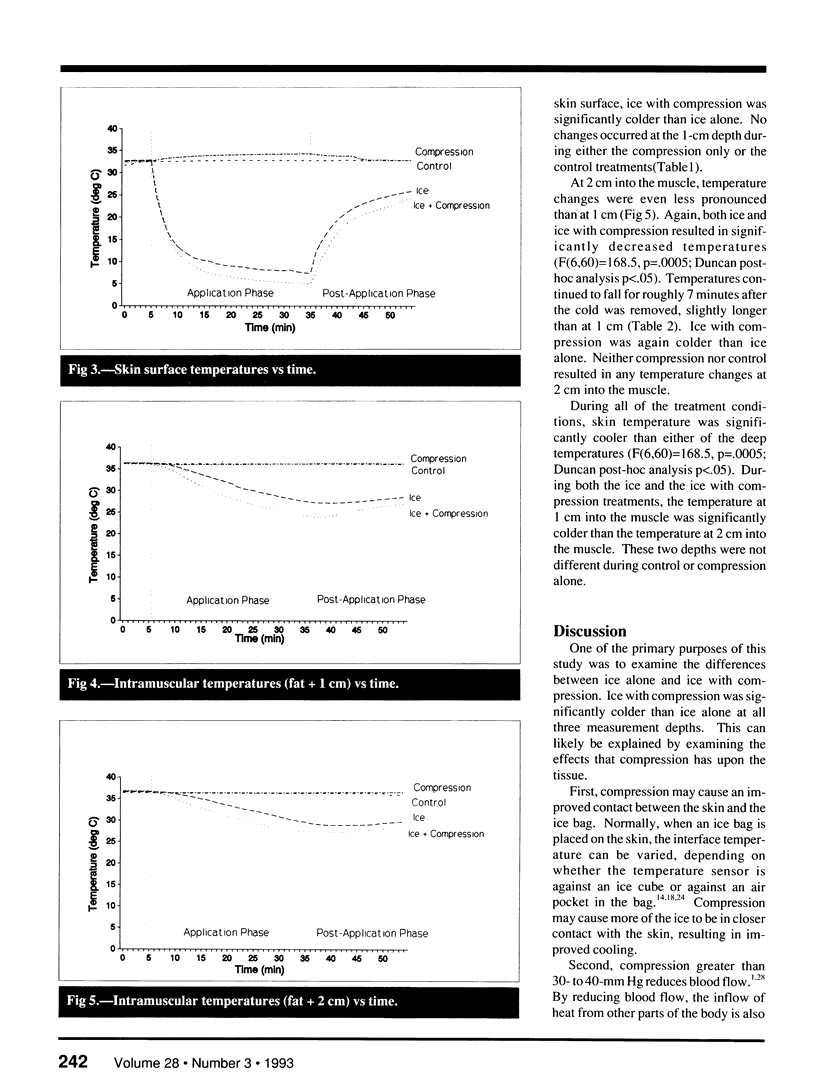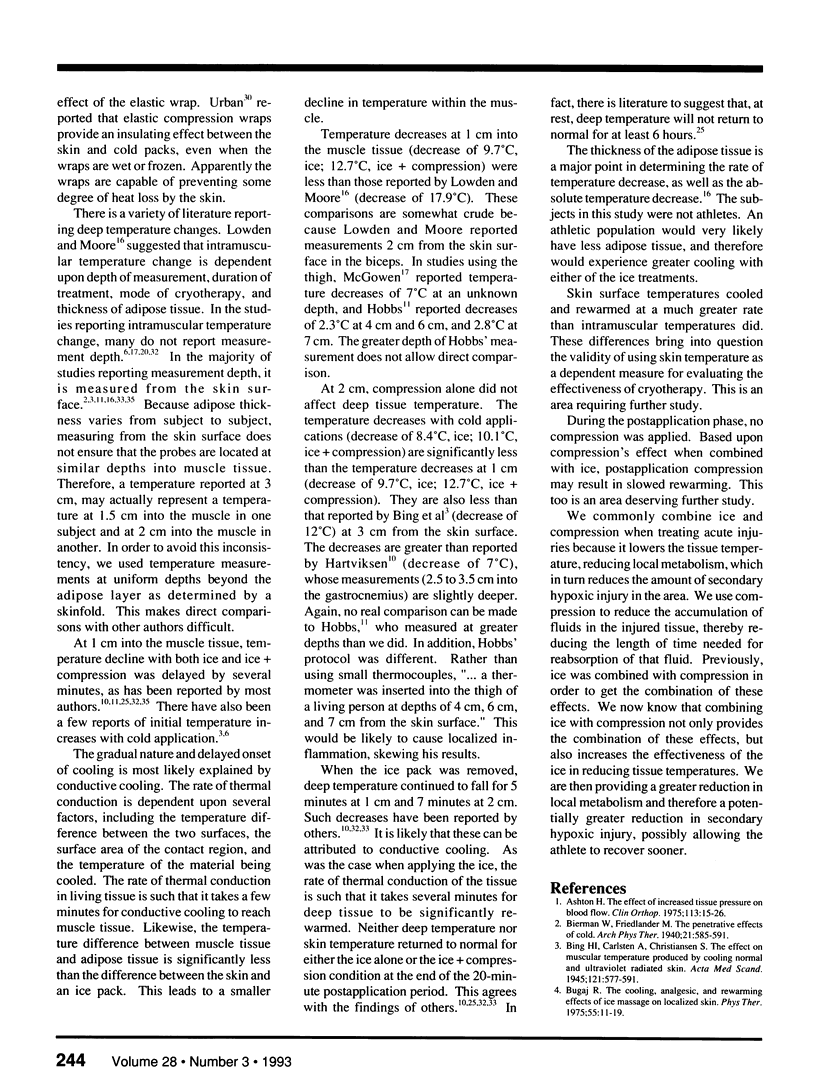Abstract
While ice and compression wraps are commonly used to treat musculoskeletal injuries, the literature describing intramuscular temperatures has not addressed the combination of ice and compression wraps. The purpose of this study was to evaluate intramuscular temperatures at three sites on the anterior thigh (skin surface, 1 cm below the fat layer, and 2 cm below the fat layer) using both ice and compression wraps. Temperatures were recorded in 11 subjects with an isothermex, using implantable and surface thermocouples. Each subject was tested under four conditions: control, compression only, ice only, and ice + compression according to a balanced Latin square. Surface and intramuscular temperatures were recorded at 30 second intervals during 5 minutes of preapplication, 30 minutes application, and 20 minutes postapplication. A repeated measures ANOVA and Duncan post hoc tests were used to evaluate peak temperature differences between the treatment conditions and the depths of measurement. Both ice alone and ice + compression produced significant cooling at all three depths (F(6,60) = 168.5, p<.0005). Likewise, during the 20-minute postapplication period, these temperatures did not return to their preapplication levels. The compression-only condition produced significant warming at the skin surface, but did not have any effect on intramuscular temperature. At all depths, the ice + compression condition produced significantly cooler temperatures than ice alone. We suggest that compression increases the effectiveness of ice in reducing tissue temperatures. Therefore, ice combined with compression should be more effective than ice alone in reducing the metabolism of injured tissue. This provides an additional rationale for combining ice with compression in treating acute musculoskeletal injuries.
Full text
PDF






Images in this article
Selected References
These references are in PubMed. This may not be the complete list of references from this article.
- Ashton H. The effect of increased tissue pressure on blood flow. Clin Orthop Relat Res. 1975 Nov-Dec;(113):15–26. doi: 10.1097/00003086-197511000-00004. [DOI] [PubMed] [Google Scholar]
- Bugaj R. The cooling, analgesic, and rewarming effects of ice massage on localized skin. Phys Ther. 1975 Jan;55(1):11–19. doi: 10.1093/ptj/55.1.11. [DOI] [PubMed] [Google Scholar]
- CLARKE R. S., HELLON R. F., LIND A. R. The duration of sustained contractions of the human forearm at different muscle temperatures. J Physiol. 1958 Oct 31;143(3):454–473. doi: 10.1113/jphysiol.1958.sp006071. [DOI] [PMC free article] [PubMed] [Google Scholar]
- Florack G., Sutherland D. E., Ascherl R., Heil J., Erhardt W., Najarian J. S. Definition of normothermic ischemia limits for kidney and pancreas grafts. J Surg Res. 1986 Jun;40(6):550–563. doi: 10.1016/0022-4804(86)90097-1. [DOI] [PubMed] [Google Scholar]
- Hochachka P. W. Metabolic arrest. Intensive Care Med. 1986;12(3):127–133. doi: 10.1007/BF00254926. [DOI] [PubMed] [Google Scholar]
- Kellett J. Acute soft tissue injuries--a review of the literature. Med Sci Sports Exerc. 1986 Oct;18(5):489–500. [PubMed] [Google Scholar]
- Lowdon B. J., Moore R. J. Determinants and nature of intramuscular temperature changes during cold therapy. Am J Phys Med. 1975 Oct;54(5):223–233. [PubMed] [Google Scholar]
- Mancuso D. L., Knight K. L. Effects of Prior Physical Activity on Skin Surface Temperature Response of the Ankle During and After a 30-minute Ice Pack Application. J Athl Train. 1992;27(3):242–249. [PMC free article] [PubMed] [Google Scholar]
- May J. W., Jr, Hergrueter C. A., Hansen R. H. Seven-digit replantation: digit survival after 39 hours of cold ischemia. Plast Reconstr Surg. 1986 Oct;78(4):522–525. doi: 10.1097/00006534-198610000-00017. [DOI] [PubMed] [Google Scholar]
- McGown H. L. Effects of cold application on maximal isometric contraction. Phys Ther. 1967 Mar;47(3):185–192. doi: 10.1093/ptj/47.3.185. [DOI] [PubMed] [Google Scholar]
- Mecomber S. A., Herman R. M. Effects of local hypothermia on reflex and voluntary activity. Phys Ther. 1971 Mar;51(3):271–281. doi: 10.1093/ptj/51.3.271. [DOI] [PubMed] [Google Scholar]
- Meeusen R., Lievens P. The use of cryotherapy in sports injuries. Sports Med. 1986 Nov-Dec;3(6):398–414. doi: 10.2165/00007256-198603060-00002. [DOI] [PubMed] [Google Scholar]
- Michael E. D., Jr, Katch F. I. Prediction of body density from skin-fold and girth measurements of 17-year-old boys. J Appl Physiol. 1968 Dec;25(6):747–750. doi: 10.1152/jappl.1968.25.6.747. [DOI] [PubMed] [Google Scholar]
- PETAJAN J. H., WATTS N. Effects of cooling on the triceps surae reflex. Am J Phys Med. 1962 Dec;41:240–251. [PubMed] [Google Scholar]
- Steffen J. M. Glucose, glycogen, and insulin responses in the hypothermic rat. Cryobiology. 1988 Apr;25(2):94–101. doi: 10.1016/0011-2240(88)90002-8. [DOI] [PubMed] [Google Scholar]
- Torlińska T., Paluszak J., Koźlik J., Kruk D., Gryczka A. Z., Krauss H. Activity of certain enzymes in the mitochondrial and cytoplasmic fractions of liver cells, myocardium and skeletal muscle of the rat during short-lasting hypothermia. Acta Physiol Pol. 1982 Sep-Dec;33(5-6):545–550. [PubMed] [Google Scholar]
- Wolf S. L., Basmajian J. V. Intramuscular temperature changes deep to localized cutaneous cold stimulation. Phys Ther. 1973 Dec;53(12):1284–1288. doi: 10.1093/ptj/53.12.1284. [DOI] [PubMed] [Google Scholar]



